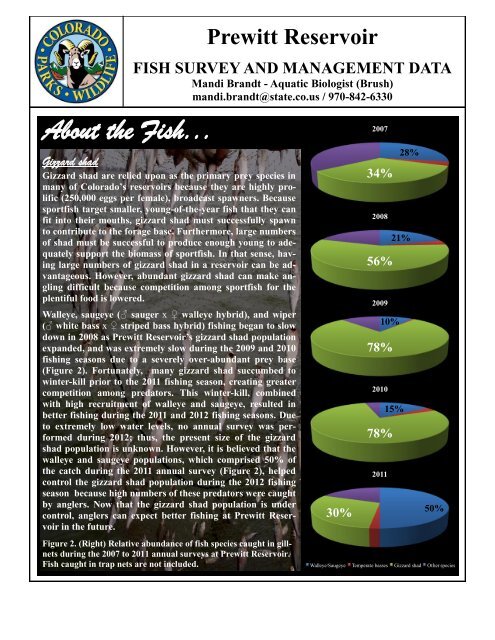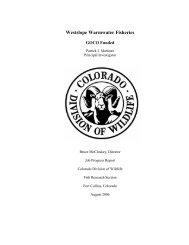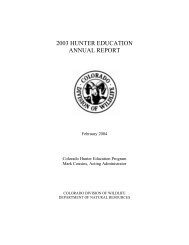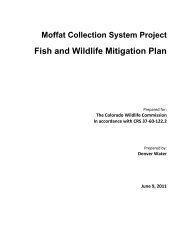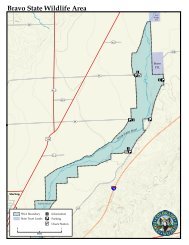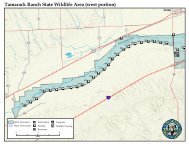Prewitt Reservoir - Colorado Division of Wildlife
Prewitt Reservoir - Colorado Division of Wildlife
Prewitt Reservoir - Colorado Division of Wildlife
You also want an ePaper? Increase the reach of your titles
YUMPU automatically turns print PDFs into web optimized ePapers that Google loves.
<strong>Prewitt</strong> <strong>Reservoir</strong><br />
FISH SURVEY AND MANAGEMENT DATA<br />
Mandi Brandt - Aquatic Biologist (Brush)<br />
mandi.brandt@state.co.us / 970-842-6330<br />
About the Fish...<br />
Gizzard shad<br />
Gizzard shad are relied upon as the primary prey species in<br />
many <strong>of</strong> <strong>Colorado</strong>’s reservoirs because they are highly prolific<br />
(250,000 eggs per female), broadcast spawners. Because<br />
sportfish target smaller, young-<strong>of</strong>-the-year fish that they can<br />
fit into their mouths, gizzard shad must successfully spawn<br />
to contribute to the forage base. Furthermore, large numbers<br />
<strong>of</strong> shad must be successful to produce enough young to adequately<br />
support the biomass <strong>of</strong> sportfish. In that sense, having<br />
large numbers <strong>of</strong> gizzard shad in a reservoir can be advantageous.<br />
However, abundant gizzard shad can make angling<br />
difficult because competition among sportfish for the<br />
plentiful food is lowered.<br />
Walleye, saugeye (♂ sauger x ♀ walleye hybrid), and wiper<br />
(♂ white bass x ♀ striped bass hybrid) fishing began to slow<br />
down in 2008 as <strong>Prewitt</strong> <strong>Reservoir</strong>’s gizzard shad population<br />
expanded, and was extremely slow during the 2009 and 2010<br />
fishing seasons due to a severely over-abundant prey base<br />
(Figure 2). Fortunately, many gizzard shad succumbed to<br />
winter-kill prior to the 2011 fishing season, creating greater<br />
competition among predators. This winter-kill, combined<br />
with high recruitment <strong>of</strong> walleye and saugeye, resulted in<br />
better fishing during the 2011 and 2012 fishing seasons. Due<br />
to extremely low water levels, no annual survey was performed<br />
during 2012; thus, the present size <strong>of</strong> the gizzard<br />
shad population is unknown. However, it is believed that the<br />
walleye and saugeye populations, which comprised 50% <strong>of</strong><br />
the catch during the 2011 annual survey (Figure 2), helped<br />
control the gizzard shad population during the 2012 fishing<br />
season because high numbers <strong>of</strong> these predators were caught<br />
by anglers. Now that the gizzard shad population is under<br />
control, anglers can expect better fishing at <strong>Prewitt</strong> <strong>Reservoir</strong><br />
in the future.<br />
Figure 2. (Right) Relative abundance <strong>of</strong> fish species caught in gillnets<br />
during the 2007 to 2011 annual surveys at <strong>Prewitt</strong> <strong>Reservoir</strong>.<br />
Fish caught in trap nets are not included.<br />
30%<br />
2007<br />
34%<br />
2008<br />
56%<br />
2009<br />
78%<br />
2010<br />
78%<br />
2011<br />
10%<br />
28%<br />
21%<br />
15%<br />
50%<br />
Walleye/Saugeye Temperate basses Gizzard shad Other species


